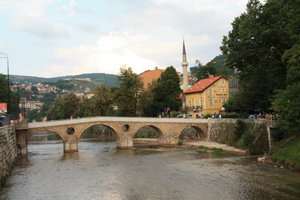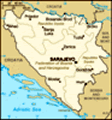Advertisement
Published: August 10th 2009

 Latin Bridge, Sarajevo
Latin Bridge, Sarajevo
The exact location of the assassination of Arch Duke Ferdinand in 1914Bosnia is not the first place one thinks of when planning their holidays, but Sarajevo and Mostar are rather striking and beautiful cities. I arrived in Belgrade, Serbia on the morning of Tuesday last week, after spending a unrestful night on the train from Budapest. I shared my sleeping compartment with three other men, who all spoke German. We had a 2 am wake up call to cross the border, first to leave Hungary and a passport stamp and then a few minutes later as the train moved forward a few miles and another passport stamp as we entered Serbia. Belgrade was not quite what I expected as we passed a small shanty town next to the train tracks: tin roofs, piles of old tires holding the roofs together and people washing clothes in a communal make shift bath. Garbage everywhere. We arrived and said goodbye to my fellow companions for that overnight portion of my trip, and I walked up the hill to my first choice of accommodation, and recommended in Lonely Planet. The hotel had a room and by 8 am I was upstairs having a shower. The room was fine, in a three star hotel, a welcome change
after weeks in shared accommodation. The bathroom had a serious mould problem, but I had a room to myself, air conditioning and English television.
In Belgrade, I walked around the city and up to the Citadel. I also walked to the Sava Orthodox Cathedral and I went into the Nikola Tesla Museum. Included in this museum tour was a film about his life, and a few demonstrations of his inventions. Tesla has been called the Inventor of the 20th Century. He invented, or is that discovered?, AC electrical power and the transformer, something we simply cannot live without today. By chance, walking the streets of Belgrade I met three students from my school that I teach. We only spoke for a few seconds, as they said hello, then sorry to have bothered me and took off into the crowded streets as quickly as they appeared. I stayed in Belgrade only two nights, but this was two full days as I had arrived early on the first morning. It was cloudy the entire time, and we had a couple of heavy rain showers. The Belgrade Citadel was interesting as it looked more like a traditional fort, with towers, crenelations and
ruins. Included here is a Military Museum. Outside there are many guns from WWI fully restored and painted, although I doubt they will fire. And inside a exhibit of Serbian military history dating back to the Roman times through the Ottoman occupation right up to the NATO Air Strikes of the Spring of 1999. There is a fragment of a US fighter jet, and a uniform of a US soldier captured by Serbia.
From Belgrade, I took the bus to Sarajevo. Eight hours with only water and a few biscuits to eat. We had a couple of toilet breaks, but by the time we arrived I was starving. We arrived at a bus station far out of town and not the main bus station located on my Lonely Planet map. I started to walk, but soon realized that I needed help. I got a Taxi and went to the famous Holiday Inn. This place was opened for the 1984 Olympics, but during the seige of Sarajevo, it was the last functioning hotel for the embattled journalists, with a fine view of sniper alley. A few bullet holes remain in the side of the building. I stayed two nights at
this 5 star hotel, but it was too expensive for my budget. Any money I had saved staying in hostels was quickly spent here. The third night in Sarajevo I went to another hotel, cheaper, in the centre of town, and still a five star hotel. I had the internet in the room for no extra charge, which I fully exploited. Sarajevo was like a breath of fresh air compared to Belgrade. There is a fabulous Old Turkish Quarter, and many Mosques. I stook at the very corner where Gavrilo Princip assasinated Arch Duke Ferdinand that triggered the First World War, you could say the event that ushered in the modern 20th Century. Coincidently, I stood at this corner and wandered through the adjacent museum the day after English Harry Patch was buried. He was the last surviving regular army soldier of the trenches in WWI. In the tiny museum, there is the gun used, and even the trousers worn by the assasin.
From Sarajevo, I took the bus to Mostar. This was only a comparatively short three hour trip. The scenary was spectacular, as we passed through the Bosnian countryside, a large blue green lake, trees, tunnels, hills
and mountains. I arrived at the bus station and was approached by a man offering rooms. I took a chance and followed him. The room is clean and centrally located, although it is noisy because the window faces the busy street, and the bathroom needs some more work after all the war damage. It is quite a dive after three nights of 5 star accommodation. But the price is what I would pay in a shared hostel, and I get to watch CNN. The Old Town of Mostar looks great, and the Old Bridge is absolutely spectacular. Photos will have to wait a few days. The bridge was built by the Ottoman Turks in the 1500s, it survived Nazi Tanks but was destroyed by the Bosnian Croats in 1993. By 2004 it was rebuilt, the whole old town is designated as a UNESCO World Heritage Site. There is still lots of visible war damage here in Mostar, a few bombed out buildings and bullet holes. One could argue that here as Yugoslavia broke apart with all this violence, this marks the end of the 20th Century, where it all began. There is no more conflict here and the tourists are
returning, in bigger numbers than were here before the war. Most come to Mostar as a rather lengthy day trip from Dubrovnik. I am travelling in the unusual opposite direction. There are lots of tiny shops selling cheap tourist trinkets and expensive other items. Copper is a big selling item. In the evening the streets are not quite so crowded with tourists.
In the span of one week I have seen the start, finish and invention of the 20th Century here in the Balkans. There is lots to see and do, and lots of history to learn. A few words about the war, but I would never be able to explain how and why it all started. Bascially there were three sides, Serbian Orthdox who use the Cyrillic alphabet, the Croat Catholics and the Bosniak Muslims who use the Latin alphabet, like us. All three speak essentialy the same language, with a few minor differences. In Bosnia, all three groups are nearly in the same numbers, so the break up of Yugoslavia was particularly difficult and violent here. Travelling through a region allows me to learn a little about the region, a very complicated history is now a little bit more clear and understandable. To be sure, there are still some differences, as on the trip from Sarajevo to Mostar all the street signs in Cryillic have been spray painted out leaving only Latin street signs to read. And I have been unable to convert my left over Serbian money here in Bosnia. I have more to go and learn as I enter Croatia tomorrow.
Advertisement
Tot: 0.073s; Tpl: 0.018s; cc: 8; qc: 24; dbt: 0.0477s; 1; m:domysql w:travelblog (10.17.0.13); sld: 1;
; mem: 1.1mb







